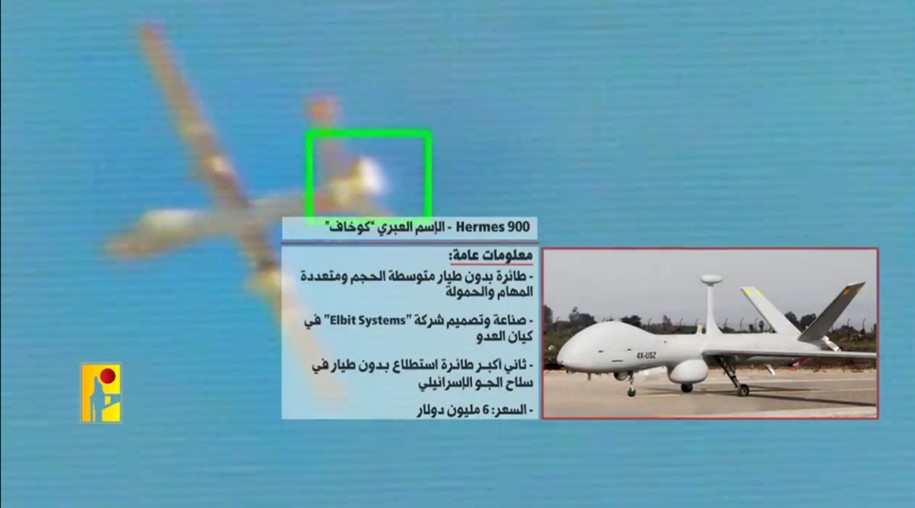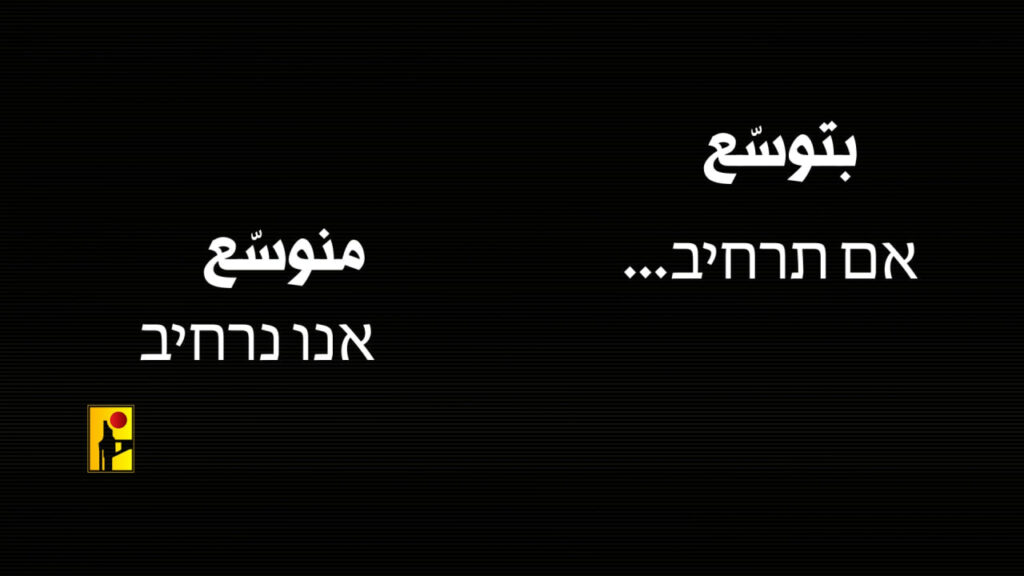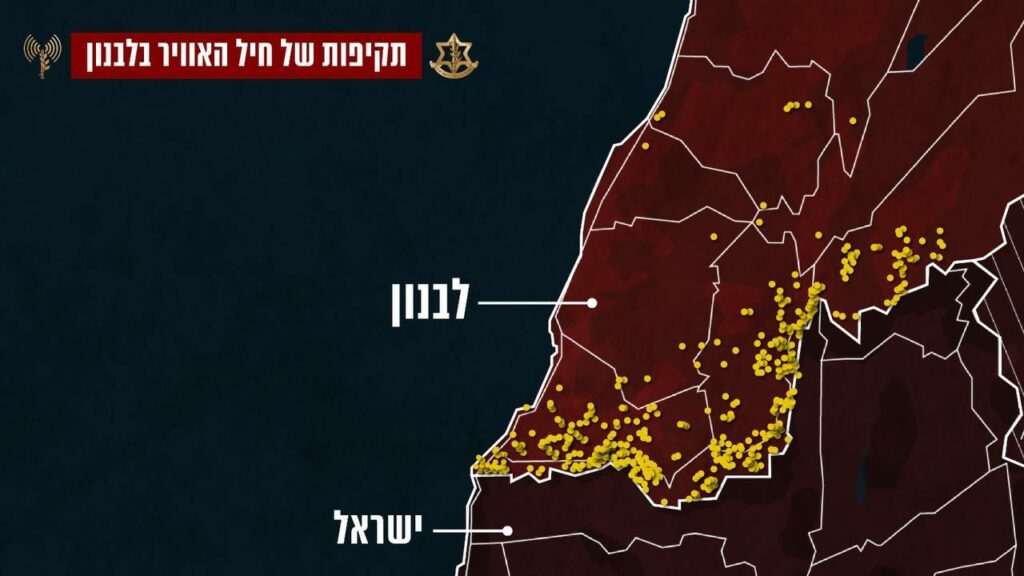By: Dana Polak Kanarik & Tal Beeri
General
As of October 8, 2023, Hezbollah (along with other organizations) initiated another front against Israel in the northern arena. Hezbollah maintains that its objective is to defend the Palestinian cause and the Gazan people, which it highlights in every claim of responsibility for its attacks on Israel. It provides support by engaging the IDF on another front, which, according to Hassan Nasrallah, reduces military pressure on Hamas and puts pressure on the Israeli leadership to end the war in the Gaza Strip.
Hezbollah assumes responsibility for its strikes on Israel, stating that the majority of its attacks are aimed at military targets. When Hezbollah claims credit for an attack on a civilian target, it justifies it by citing IDF operations against residential areas in Lebanon. There are virtually no civilian areas in southern Lebanon. Hezbollah’s military infrastructure is completely intertwined within the civilian infrastructure of southern Lebanon and cannot be separated. Hezbollah operates in residential areas, using civilians as human shields. To achieve credibility within Lebanon, Hezbollah justifies its war against Israel by claiming to be the “defender of Lebanon”.
Following Hezbollah’s initiating of the Lebanese front, the Israeli government evacuated 43 communities located up to five kilometers from the border with Lebanon. A total of about 61,000 citizens. It should be noted that some of the Israeli communities have not been fully evacuated and there is a civilian presence there. This is because these communities are based on tourism and agriculture. The farmers come to cultivate the land, work in the fields and orchards, and tend the herds of cows and goats. Furthermore, some of the communities’ industrial plants continue to operate, employing workers from non-evacuated populations. As of this writing, the Israeli government has extended the evacuation period until the summer of 2024 (July/August 2024).
Hezbollah has killed 6 Israeli civilians and an agricultural worker with foreign citizenship. A total of 7 civilians have been killed so far. In addition, 11 IDF soldiers were killed.
Hezbollah’s claims of accountability for attacks against Israel usually assert that practically every attack resulted in injuries, including fatalities. However, this is frequently inaccurate and intended to promote its achievements while contributing to psychological warfare and propaganda.
According to formal data in Israel, as of March 25, 2024, since the beginning of the war, 2,062 property damage claims have been received in the north, of which 1137 are structures.
According to the Lebanese Prime Minister Najib Mikati statement from April 4, 2024: 100,000 people have been displaced from southern Lebanon, 313 individuals have been killed (note: among them 302 military operatives) and 1,000 have been injured. Mikati also mentioned that 800 hectares of agricultural land have been destroyed.
The data provided in this summary document is based on multiple databases. These include Hezbollah and other organizations accepting responsibility through their official media, Israeli media (at least two independent sources), and announcements by the IDF Spokesperson. However, we did our best to paint a broad picture of the attacks on Israel in the northern arena during the Swords of Iron conflict.
Key insights
IDF Action
1. The scope of the IDF attacks against Hezbollah, the vast majority of which have been carried out around 0-5 km from the border so far, does not constitute a serious blow to Hezbollah’s operational capabilities. In our understanding, Hezbollah’s main arrays, which it has been operating over the past six months, such as its rocket fire array, anti-tank missiles, and air units, still maintaining their capability.
2. For example, when examining and comparing the number of rocket fire incidents in February 2024 compared to March 2024, we see that the rocket fire array, the main system operated by Hezbollah, maintains the volume/intensity of its activity, even with a small upward trend (127 launching incidents in February compared to 132 incidents in March). The intensity of operation of the UAV system also increased 3.5-fold in March compared to February. 7 launch events in February compared to 24 in March. Although the number of anti-tank missile incidents has dropped considerably from 75 incidents in February to 48 incidents in March, this is still a significant fire ability.
3. In our assessment, despite the IDF’s damage to Hezbollah’s infrastructure, it is likely that some of them are in the process of rehabilitation, while several will be rehabilitated within a short time.
4. In light of the IDF Spokesperson’s report on the extent of the damage to targets belonging to the Radwan Force and in light of the IDF’s deployment on the border, we assess that Hezbollah will find it difficult to implement an invasion of the “occupation of the Galilee” subject to its original plan. Despite this, the ability to infiltrate into Israeli territory still exists. According to our estimate from several months ago, Hezbollah can carry out targeted offensive and penetration operations into a specific sector with fewer Radwan operatives with the support of the geographic units.
5. The IDF seeks to target senior professional knowledge centers inside Hezbollah’s operational network, such as, Hezbollah’s deputy commander of the rocket firing array, Ali Na’im-Abu Mahdi the African (“Al-Afriki”). At the same time, it continues to cause damage to the Radwan unit’s command structure. As of this writing, the unit’s five senior leaders had been struck: Wassam al-Tawil, Ali Muhammad al-Dabas, Hassan Mahmoud Saleh, Abbas Muhammad Ra’ad, and Ismail Ali al-Zein. The obvious question is: how much does this loss damage the unit’s competence over time?
6. According to foreign reports, the airstrikes against CERS sites in Syria, such as the Suleiman site (March 29, 2024) and the Jamraya-Dumar site (March 31, 2024), indicate, among other things, that there is a significant acceleration in the activity of the Iranian arms corridor and its infrastructure in Syria (including CERS facilities). As we have reported in the past, the Iranian trend is to establish a weapons production and development infrastructure on Syrian soil based on Iranian know-how, using the existing platform of CERS sites. Thus, the weapons are transferred directly to Hezbollah in Lebanon and to the Shiite militias in Syria without having to transport them from Iran.
7. An opportunity must be seized to intensify and even fully destroy all infrastructure and CERS sites in Syria, which are becoming, according to Iranian directives, the foundation of advanced conventional weapon research, development, and manufacture. Furthermore, it should be noted that Assad’s chemical weapons arsenal (which has not been destroyed and may flow over to Hezbollah) is manufactured and stored at CERS installations.
8. Israel appears to be targeting Hamas’ ability to direct and incite terrorism from Lebanon, as evidenced by the elimination of senior Hamas operatives in Lebanon. Hadi Ali Mustafa (March 13, 2024), Khalil Kharaz (November 2023), Salah al-Arouri, and his assistant Samir Fendi (January 2024), all eliminated in Lebanon, were involved in planning, and conducting terrorist attacks on Israeli targets in Israel and around the world.
9. So far, we haven’t seen an “escalation” in IDF activities. Any military element or group that acts directly against Israel in the context of ongoing combat and directly threatens it because of its military activities is a clear target. in our view, an escalation is a counterinsurgency activity in an unusual geographical area against unique targets. For example, activities in a geographic arena that is not a direct combat sector, in which strategic military array of the shia axis and officials are stationed who are not directly involved in the fighting at this time, given an escalation, they will become an extremely important component.
Hezbollah airstrikes
1. Hezbollah’s activity must be examined as part of its response to the Israeli response. Hezbollah’s activity is sometimes in relation to and in response to the nature of the targets attacked, referring not only to the Lebanese arena but also to the Syrian arena. In other words, how much the attack hurt Hezbollah.
2. Hezbollah aspires to preserve a tit for tat equation it established from before the war. Hezbollah is careful to note in its statements that when it attacks a clear civilian target, it is in response to IDF attacks on civilian areas in Lebanon. Thus, Hezbollah justifies its involvement in the war towards the internal Lebanese arena by virtue of its role as the “defender of Lebanon.” Hezbollah only forgets to mention that its main tactic is operating using the human shield tactic…
3. Since the beginning of the war, there has been an upward trend in attacks against civilian targets: in October 45 of the attacks were against civilian or potentially civilian targets, and in March there were 117, 2.5 times more. Since the beginning of the war, there have been 583 attacks against civilian targets, constituting 40% of all attacks. Our definition of a civilian target is both when there is direct and deliberate strike (according to Hezbollah’s claims of responsibility) and when the attack has a high potential for damage to civilian areas. This is also the case even if Hezbollah defined the target as an ostensibly military target.
4. During the war we saw several cases that attest to the preservation of the equation of mutual aggression between the IDF and Hezbollah (“ping-pong”). When one side steps up and attacks a qualitative or farther target, the other side increases its intensity accordingly.
5. Another equation that was established in the war is an aerial equation: an attack by a Hezbollah UAV = an IDF attack on Hezbollah air unit targets. For that matter, an airstrike by Hezbollah using UAVs will be answered by an attack on a quality target, seemingly connected to Hezbollah’s aerial system, deep inside Lebanon. In addition, an attack on an IDF UAV by anti-aircraft fire will lead to an IDF attack on Hezbollah’s air defense systems. Accordingly, Hezbollah will respond by attacking air force bases which, it claims, are part of the IDF’s air defense system.
6. It’s worth noting that Hezbollah rarely claims responsibility for most of its UAV launches. For example, in March 2024, Hezbollah claimed responsibility for only 4 out of 24 UAV launches. This may be an attempt to avoid an Israeli “equational response.” Also, not all of Hezbollah UAVs launched toward Israel are suicide UAVs as some are used for intelligence gathering, thus Hezbollah does not claim responsibility for their launch.
7. The war initiated by Hezbollah against Israel on October 8 has stayed relatively stable over the last six months. Enough to keep Hezbollah in the headlines and avoid accusations that it ignores the Palestinians, but not enough to pull Israel into a full-scale conflict.
8. At the start of the war, Hezbollah’s primary weapon was the firing of anti-tank missiles. The usage of rocket firing has increased steadily since January 2024. However, anti-tank missiles continue to be fired, and their range suggests the presence of Hezbollah operatives in the kilometer-long area near the border. In other words, Hezbollah operatives continue to operate along the border.
9. Most Hezbollah operatives in units operating in southern Lebanon live south of the Litani River. They will not withdraw. They live there.
10. Throughout the war, Hezbollah has expanded its military and civilian targets. Beginning in November 2023, Hezbollah began using new weapons like as heavy rockets (Burkan and Grad) and unmanned aerial vehicles (UAVs) for attack. In January 2024, Hezbollah began using Falaq rockets and Almas – anti-tank missile. In addition, as the combat progressed, Hezbollah began to utilize multi-barrel launchers.
Organizations operating alongside Hezbollah in Lebanon
1. Alongside Hezbollah, which leads the fighting against Israel on the Lebanese border, other organizations operate under its guidance and coordination. Amal is a full and dominant partner in the fighting together with Hezbollah. Its military operatives mostly fire rockets and anti-tank missiles into Israeli territory. Al-Fajr, the military wing of the Muslim Brotherhood, Al-Jama’ah al-Islamiyah, is also a partner. It claimed it had fired rockets at Israel several times during the war. Also operating in the southern Lebanese arena against Israel are Hamas, the PIJ, the Syrian Socialist Movement, operatives of the Imam Hussein militia, and local operatives (Sunni and Druze) who constitute a local proxy of Hezbollah – the Lebanese Resistance Brigades.
2. The number of announcements and public claims of responsibility by the Shi’ite resistance in Iraq for attacks against Israel (launching UAVs) increased as the war progressed. The organization claimed to have attacked military targets and critical infrastructure in Israel. It should be noted that public notice and claim of responsibility does not necessarily indicate that an attack was actually carried out, and that in most cases there was no indication of an attack. April 1 was the first incident in which a UAV with Iranian characteristics managed to penetrate the air defense systems and strike the naval base in Eilat. In this report we included only the attacks of the Shi’ite resistance in Iraq on the northern of Israel.
3. Iran is attempting to distinguish itself from the proxy’s activity, but by simply identifying the weapons used by the proxy reveals who is the sole force builder and director behind the scenes: Iranian anti-aircraft missiles, Iranian UAVs, Iranian anti-ship missiles, Iranian anti-tank missiles, Iranian rockets, Iranian sniper rifles, and more.
Neutralized officials and operatives
1. So far, a total of 34 senior officials have been eliminated: 18 Iranians (including senior officials and advisors), 12 Hezbollah, and 4 Hamas and Lebanon.
2. As of this writing, about 323 military operatives in total have been killed in the conflict in the north. Of these, 270 are Hezbollah operatives and about 53 (about 16%) belong to the forces supporting Hezbollah in the fighting in Lebanon: Amal Movement (18), Hamas (6), and the Muslim Brotherhood (under Hamas aegis) (10), PIJ (5).
3. Hezbollah is very concerned regarding the depth of Israeli intelligence penetration. This was also reflected in Nasrallah’s speech (February 13, 2024), in which he called to give up the use of mobile phones, as well as arrests and increased security in the Dahiya area of Beirut.
4. Everyone has a replacement. Even for those who were eliminated, who are experienced and professional centers of knowledge. However, beyond certain operational damage, the elimination also has a symbolic-consciousness-psychological effect, which is sometimes no less important than the de facto operational harm. In a state of war, it is sometimes even more important, in that it will also affect the continuation of operational conduct.
5. The sense of infiltration and persecution caused to the enemy as a result of eliminations forces him to stop and probe where the intelligence-security breach is. This halt affects operational conduct.
Negotiations for a ceasefire
1. The United States is pressing for a ceasefire on both the northern and southern fronts. On the other hand, it seems that neither Hezbollah nor Hamas are interested in moving forward in the negotiations: Hezbollah is in no hurry to create a political settlement with Israel, and Hamas is in no hurry to reach a deal for the release of the hostages. This allows Israel to continue to produce limited military achievements in southern Lebanon. But at the same time, it is delaying the planned Israeli operation in Rafah.
2. We doubt reports of Iranian pressure on Hezbollah to prevent escalation. This may be another stage in Iran’s management of its psychological warfare and in the Iranians’ attempt to differentiate themselves and misrepresent themselves as a moderating element. In our understanding, the general interest of Iran and Hezbollah is the opposite – to turn Israel into a war initiator, striving for regional escalation, thereby losing legitimacy. This interest, along with Hezbollah’s other long-term interests, was already expressed about a year before the outbreak of the war: Hezbollah’s repeated attempts to escalate the situation and “draw” Israel into the conflict (fence incidents, Megiddo attack, rocket and anti-tank fire, the pitching of tents at Har Dov, etc.). It’s all about timing.
3. As negotiations for any agreement in southern Lebanon progress and reports of such an accord emerge, we believe Hezbollah will be urged to seek a picture of victory.
Analysis of Hezbollah’s data and trends (attacks, types of weapons and targets)
The total numbers of attacks on the Israeli northern border is 1,455. Hezbollah claimed responsibility for 1,222 attacks in total. In the last cuple of month the average of attacks was about 50 per week.
The figures show that from October 2023 to December 2023 there was a sustained increase in the number of attacks against Israel on the northern border: in October there were 161 attacks, in November 225, and in December, the month with the most attacks to date, there were 292 attacks. January and February had almost the same number of attacks, January 2024- 220, and February 2024- 219, which marked a process of decline, but in March there was an increase and there were 284 attacks.
In terms of weapons, at the beginning of the war the main weapon was the launching of anti-tank missiles, alongside the use of high-trajectory rockets, UAVs and air defense means. However, from January 2024 there was a decline in the use of anti-tank missiles alongside an increase in the use of high-trajectory rocket fire, which is currently the weapon of the war in the north.
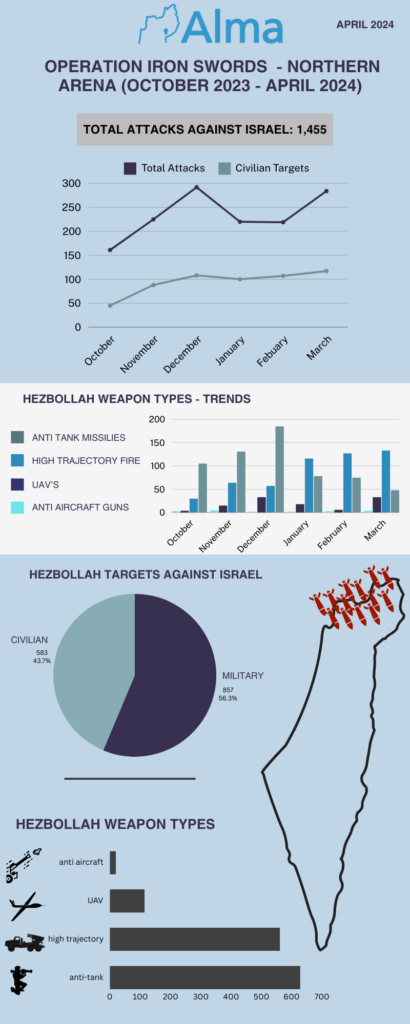
Since the beginning of the war, Hezbollah and the other organizations attacking Israel on the northern border have been attacking military but also civilian targets. From October 2023 to this writing, there has been a sustained increase in attacks against civilian targets in Israel, including civilians, homes, buildings and vehicles in communities and cities near the border. In October, 45 of the attacks on the northern border were against civilian or potential civilian targets, and in March 2024 there were 117, 2.5 times more than in October 2023. Since the beginning of the war, a total of 583 attacks have been carried out against civilian targets, constituting 40% of all attacks in the northern theater. We define a civilian target when there is a direct and deliberate strike (according to Hezbollah’s claims of responsibility) and also cases in which the attack has a high potential for damage to civilian areas, mainly high-trajectory fire. This is true even if Hezbollah has defined the alleged target as a military target (examples of such incidents in Appendix 3 – Targets).
If we look at the total number of attacks since the beginning of the war, there were still more incidents of the use of anti-tank missiles than all other weapons in the attacks on the northern border. It should be noted that the data is based on the number of incidents in which each weapon was used, and not on the number of weapons fired in each incident. For example, an incident involving the firing of 60 rockets is counted as one incident.
Appendices:
Appendix 1
Terrorist organizations operating in the northern arena in the Swords of Iron War
Since October 7, when Hamas began its murderous offensive, and as part of its strategy of “unifying the arenas” against Israel, several pro-Iranian and Palestinian terrorist organizations have joined the fighting on Israel’s northern border, carrying out attacks against Israel. Most of the attacks are carried out from Lebanese soil and some from Syria, Iraq, and Yemen.
Lebanon
Alongside Hezbollah, which leads the fighting against Israel on the Lebanese border, other organizations operate under its guidance and coordination: Hamas, the Muslim Brotherhood in Lebanon (Al-Fajr, which operates under Hamas’ aegis), the Palestinian Islamic Jihad (Al-Sami), the Imam Hussein Division, the Amal Movement, the Syrian National Socialist Party, and the Lebanese Resistance Brigades.

Hezbollah joined the Swords of Iron War on October 8 and began carrying out attacks against Israel. Hezbollah’s joining the war is justified both as moral support for the Palestinian resistance and the people of Gaza and to engage Israel, which is forced to divert its forces to the north. The opening of the front in Lebanon forced Israel to reinforce the northern border with additional forces which, according to Nasrallah, were supposed to be part of the forces fighting in the Gaza Strip (Nasrallah’s speech, November 3, 2023). This is also the support the Shiite militias in Iraq and the Houthis in Yemen lend to Hamas, posing a threat to Israel on all its borders, from north to south (Nasrallah’s speech on Martyrs’ Day, November 11, 2023).
Hezbollah tends to claim responsibility and publicize its attacks against Israel daily, through its media channels. Hezbollah’s combat media arm often publishes videos and photos documenting attacks against Israel. Since the beginning of the war, Hezbollah has assumed responsibility for 1,222 attacks (out of 1,455 total) against Israel, not including incidents for which it did not admit responsibility, most of which were Hezbollah UAV infiltrations into Israeli territory.
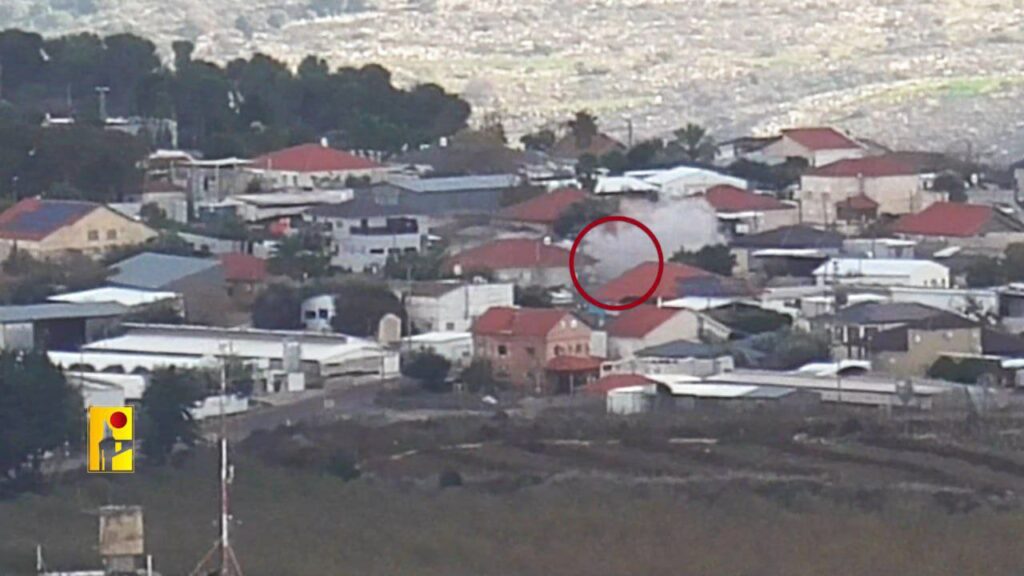
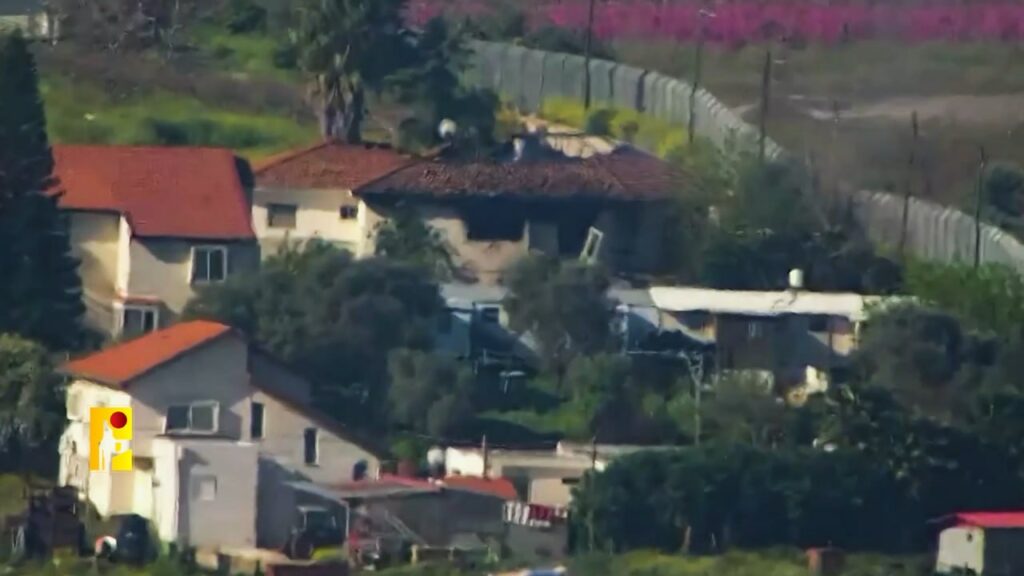
Hamas maintains a military wing in Lebanon, with its primary headquarters in Sidon. Military activities in Lebanon are overseen by Hamas’ “Construction Bureau,” with some personnel headquartered in Turkey and some in Lebanon. Hamas’s involvement in Lebanon is primarily centered on refugee camps with a large Palestinian population. The Palestine branch of the Quds Force of the Iranian Revolutionary Guards provides support, mentoring, and oversight of Hamas’ military activities in Lebanon.
In the current war, Hamas’ military-terrorist wing in Lebanon has primarily fired rockets at the Western sector, as well as the city of Kiryat Shmona. The organization’s freedom to operate in southern Lebanon was curtailed as the war proceeded. From daily attacks in October 2023, the organization reduced to an average of one attack per month. The latest operation for which it claimed responsibility occurred on February 28, 2024, when Hamas’ military-terrorist wing launched approximately 40 Grad rockets into the city of Kiryat Shmona.

Since the beginning of the war, Israel has also been operating and carrying out attacks against Hamas operatives in Lebanon, killing 6 Hamas operatives. On January 2, 2024, senior Hamas figure Salah al-Arouri, responsible for terrorist activity in Judea and Samaria and deputy head of Hamas’ political bureau, was eliminated in Beirut. Other significant operatives killed were Hadi Ali Mustafa (March 13), an operative in Hamas’ Construction Bureau, al-Arouri assistant Samir Fendi, also a senior figure in Hamas’ Construction Bureau, and Khalil Kharraz. All of them are involved in planning and directing terrorist attacks against Israeli and Jewish targets in Israel and around the world.
Hamas’ Construction Bureau attends to the strengthening of Hamas’ military-terrorist wing and directing terrorist attacks against Israeli and Jewish targets. Israel appears to be acting in a targeted manner to undermine Hamas’ ability to direct and encourage terrorism from Lebanon. This is especially important considering the fear of a flare-up during Ramadan.
Another organization operating against Israel in Lebanon is Al-Jama’ah al-Islamiyah, the Lebanese Muslim Brotherhood organization, which operates under the auspices of Hamas. The organization in Lebanon is headed by Mohammed Takush, who was elected secretary-general in 2022. With the outbreak of the Arab Spring, the movement began official political activity in Lebanon and today, Imad al-Huth, is a member of the Lebanese parliament on its behalf.
Al-Jamaah al-Islamiyah declared on October 18, 2023, that its military wing, the Al-Fajr Forces, had fired rockets at Israeli military bases for the first time (see attachment). Since then, the organization has made two additional claims of responsibility for attacks against Israel. The organization fires mostly rockets into Israeli territory, and 10 Al-Fajr members have been eliminated since the war began.

The Martyr Ali al-Aswad Brigade, a military wing of the Palestinian Islamic Jihad, operates in Lebanon. Since the start of the war, the group has claimed credit for two strikes in October 2023. (08.10, 30.10) of attempted terrorist infiltration into Israeli territory.
The Shiite Amal movement is also involved in the war against Israel in Lebanon. Amal, like Hezbollah, engages in political activities, and its leader, Nabih Berri, is the speaker of the Lebanese parliament. The Amal movement has a military force of up to 17,000 members and an elite squad of 2,200 combatants operating in southern Lebanon villages. Nabih Berri formally proclaimed on February 11, 2024, that Amal has been involved in the war against Israel since October 8, 2023. This comes after it was revealed on November 11, 2023, that the organization’s first military operative had been killed. Since the start of the war, 18 Amal military personnel were killed.
The movement’s leaders refuse to acknowledge formal credit for strikes against Israel carried out by their operatives out of concern for their military operative’s safety. As a result, the number of occasions on which Amal movement activists have launched attacks on Israel since October 8, 2023, remains unknown. Amal does not have the same military capabilities as Hezbollah; thus, they fight within their means, with its military personnel mostly firing rockets and anti-tank missiles at Israel. Amal is a complete and dominant partner fighting alongside Hezbollah.
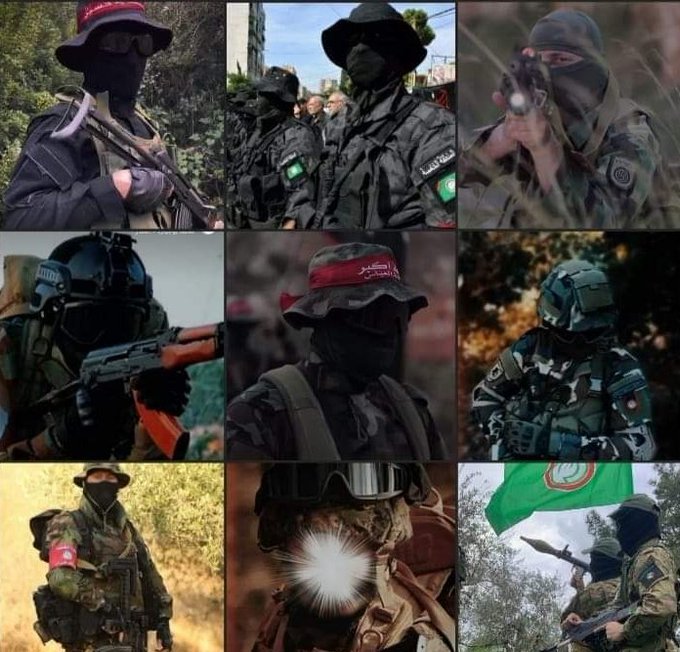
Syria
Since the beginning of the war, there have been at least 12 incidents in which rockets were launched from Syria at the Israeli Golan Heights. No responsibility was taken for these incidents. In our assessment, these are Palestinian organizations, most likely Hamas, or Palestinian Islamic Jihad operatives. It is possible that these operatives came from Damascus or were even sent from Lebanon to carry out the activity.
Iraq
As of October 17, 2023, the Islamic Resistance in Iraq has begun attacking American bases throughout Iraq and Syria, and later also carrying out attacks against Israel. In fact, it is a general name for the Shiite militias in Iraq operating under the aegis of the IRGC. Most of the attacks are carried out by launching UAVs against military targets or critical infrastructure throughout Israel. The videos documenting the attacks show that the type of UAV they are using is the Shahed 101 (pictures below are attached). In practice, in most cases, there was no indication of actual harm from any of the attacks. This is apart from the attack they carried out on April 1, 2024, on the naval base in Eilat.

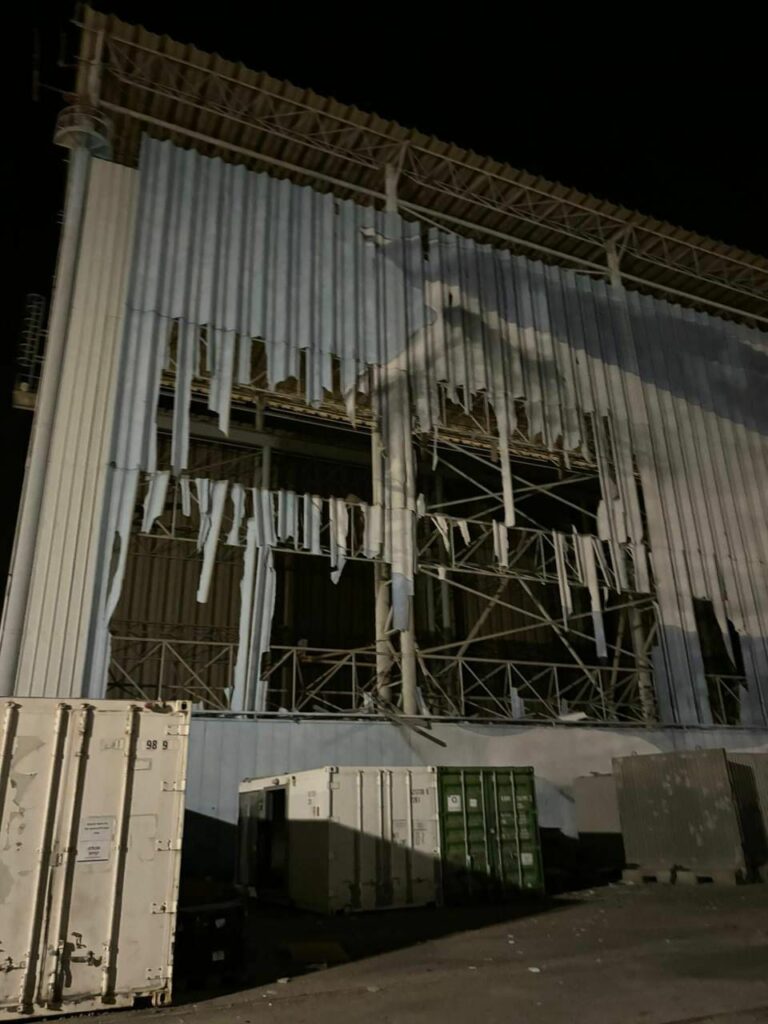
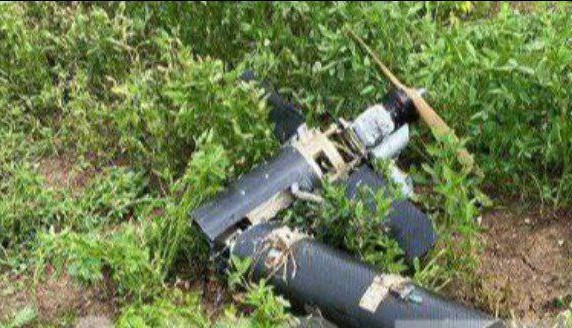
Appendix 2
Weaponry
Hezbollah’s present arsenal against Israel includes anti-tank missiles, rockets (including Grad, Falaq, and Burkan), unmanned aerial vehicles (UAVs), and air defense (anti-aircraft) systems. It should be emphasized that the data is based on the number of events in which each weapon was used, rather than the number of weapons discharged in each incident.
In the first weeks of the war, most of the attacks against Israel on the northern border were characterized by Palestinian terrorist squads attempting to penetrate Israeli territory. At the same time, rockets, anti-tank missiles and sniper fire were fired into Israeli territory. From November 2023, it has expanded its weapons arsenal, including the first use of Burkan rockets and suicide UAVs. Hezbollah later introduced Falaq rockets and Almas anti-tank missile as well.
For further information on the types of weapons used by Hezbollah in the Sword of Iron War:
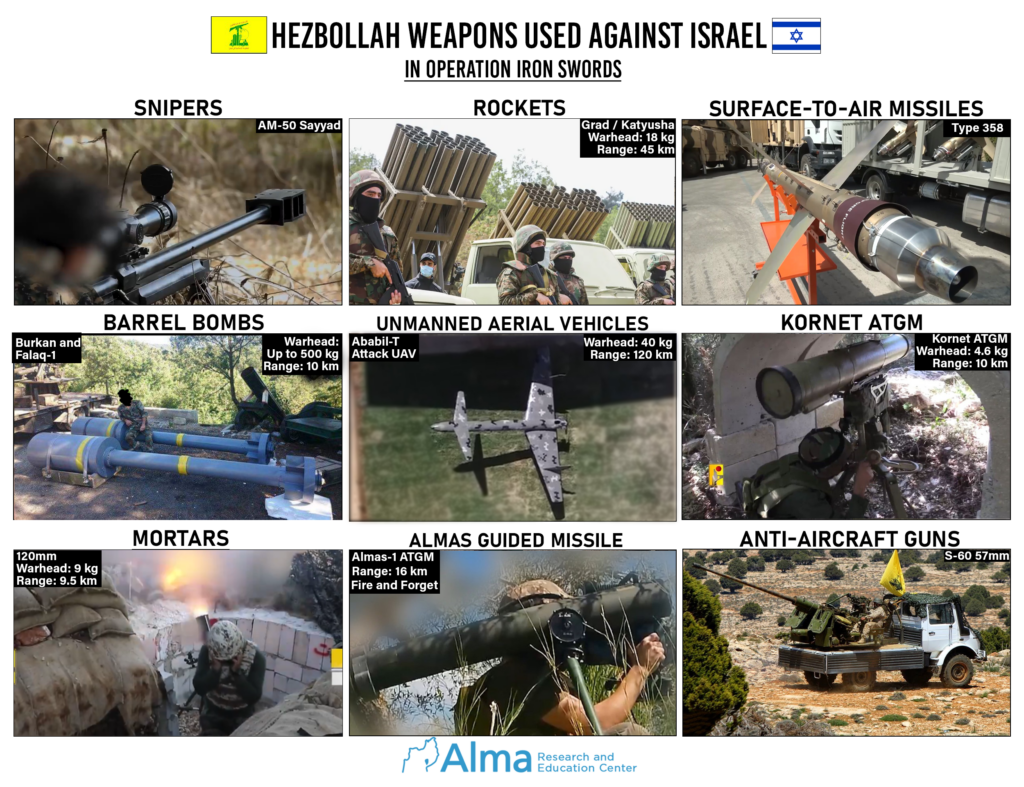
Since January 2024, Hezbollah’s use of anti-tank missiles has decreased, while rocket launches of all types against Israel has increased. Rocket fire and anti-tank missiles are Hezbollah’s most important weaponry. The range of the anti-tank missiles, as well as several of the rockets launched, suggest the presence of Hezbollah operatives near Israel’s border. This suggests that Hezbollah forces have not withdrawn from the border. It is important to note that most Hezbollah operatives in southern Lebanon live south of the Litani River. They will not withdraw simply because they live there. This is evident by the fact that 65% of Hezbollah fatalities occurred south of the Litani.
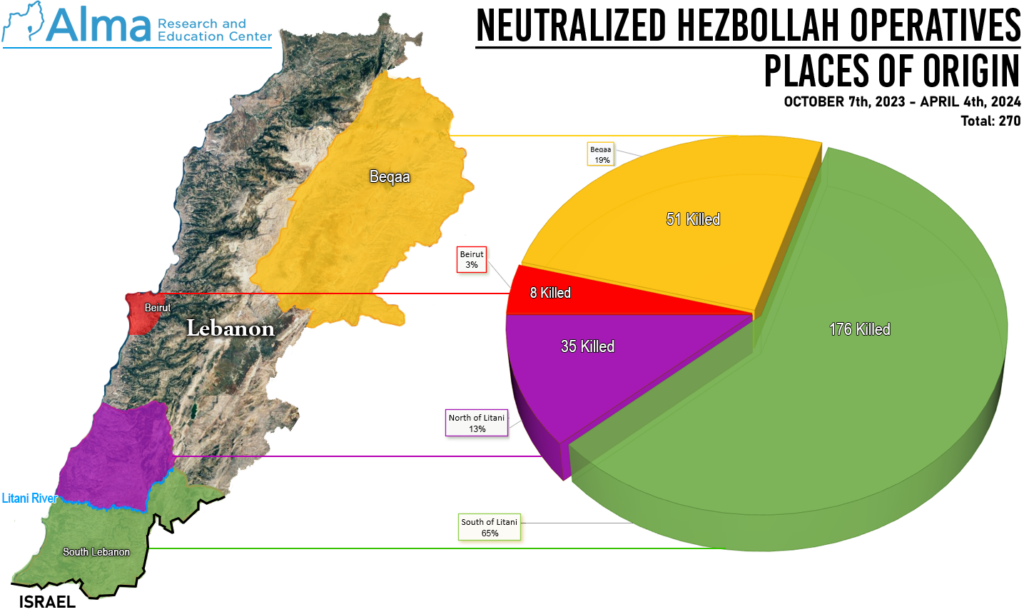
Unmanned Aerial Vehicles (UAVs)
Hezbollah possesses a sizable arsenal of Iranian-made and self-built UAVs of various types, including attack, suicide, and intelligence gathering. Hezbollah has extensive experience operating UAVs and can launch both a suicide UAV or an attack UAV. During this war, Hezbollah used suicide UAVs against Israel for the first time. Since the beginning of the war, Hezbollah has launched UAVs toward Israeli territory, some of which were intercepted, while others have landed and even reached their target. In most cases where a UAV is intercepted, Hezbollah refrains from accepting responsibility for launching toward Israel.
On December 16, 2023, a suicide UAV airstrike was carried out, killing Sgt. Maj. (res.) Yehezkel Azaria and wounding two other soldiers. As part of the attack, Hezbollah launched two UAVs and one was intercepted by the IDF. The attack was carried out using a Merced-1 UAV. This UAV has an attack range of 120 km, a speed of about 200 km, a carrying capacity of up to 40 kg of explosives and a flight capability at altitudes of up to 3,000 meters. Attached below are photos documented the attack by Hezbollah. Another target of Hezbollah’s UAV attack was an Iron Dome battery, which Hezbollah attacked with several UAVs on January 25, 2024, and again on March 23, 2024.
It should be noted that Hezbollah also utilizes, in addition to UAVs, various types of drones (most of them civilian drones converted by Hezbollah for military use, including intelligence gathering, suicide drones, and drones that drop bombs and rockets).
As previously stated, in addition to the UAV threat posed by Hezbollah, throughout the war, Shiite militias in Iraq launched UAVs at targets in Israel, including targets in northern Israel. For the most part, there was no evidence that these attacks caused damage. Most of them were intercepted or fell on route to Israel, either by the IDF or in Syria and Jordan.
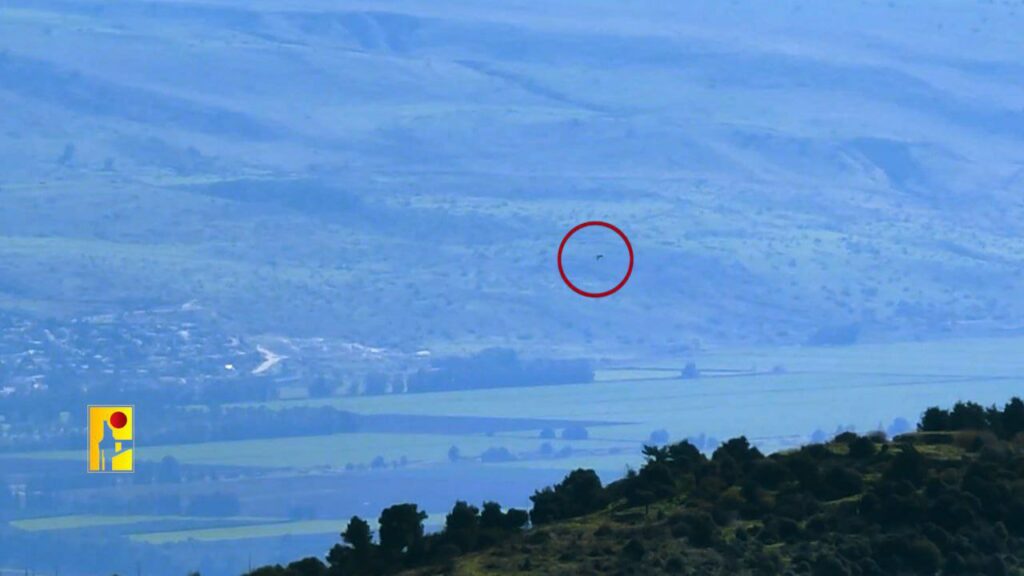

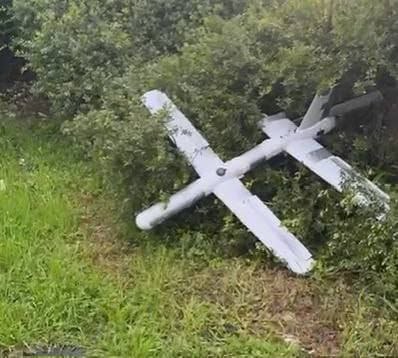
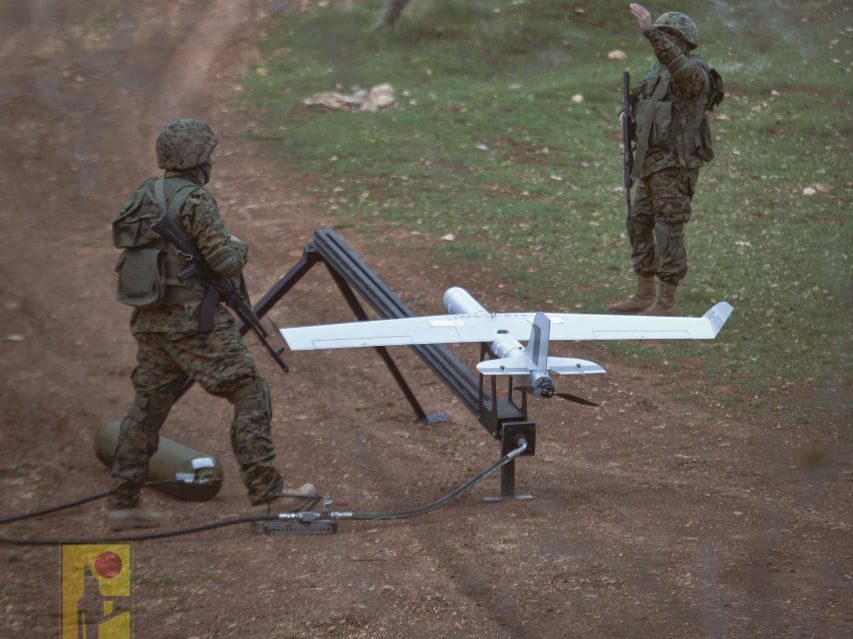
Rocket fire
Grad
Hezbollah targets Grad rockets since November 5, 2023, mainly at Israeli civilian communities along the Lebanese border.
Burkan rockets
On November 20, 2023, Hezbollah assumed responsibility for the first time for launching Burkan rockets against Israel. This rocket can carry up to 500 kg of explosives and has a range of around 10 kilometers. Since then, Hezbollah has claimed responsibility for an additional 76 Burkan rocket attacks against Israel. On March 28, 2024, Hezbollah launched Burkan rockets toward the communities of Shlomi and Goren, marking the first time Hezbollah intentionally fired at civilian targets accepting responsibility. This contrasts with past incidents in which Burkan rockets landed in civilian areas while Hezbollah claimed to have shot at military targets (See below an example of a Burkan rocket launched toward the community of Shlomi area.)
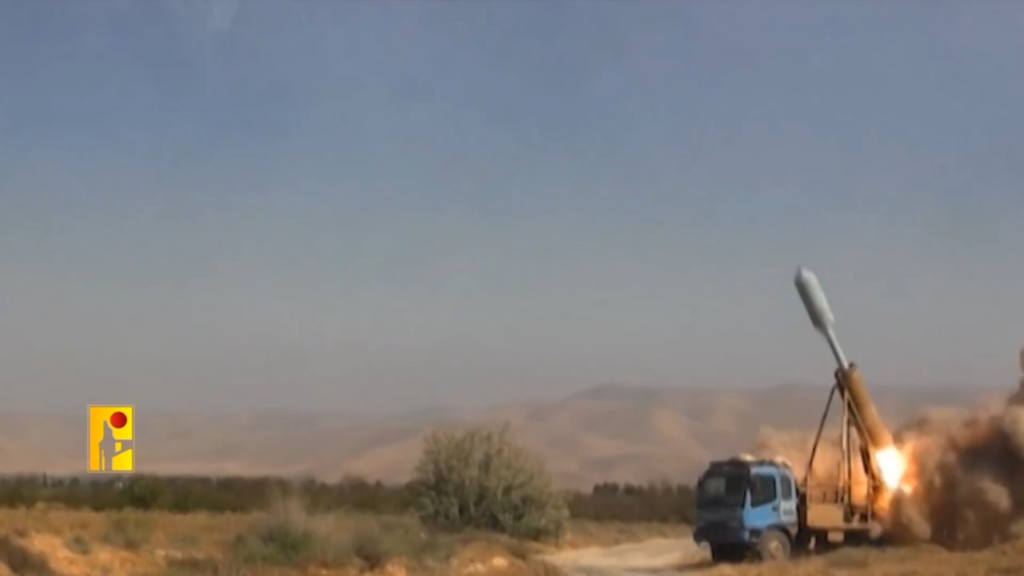
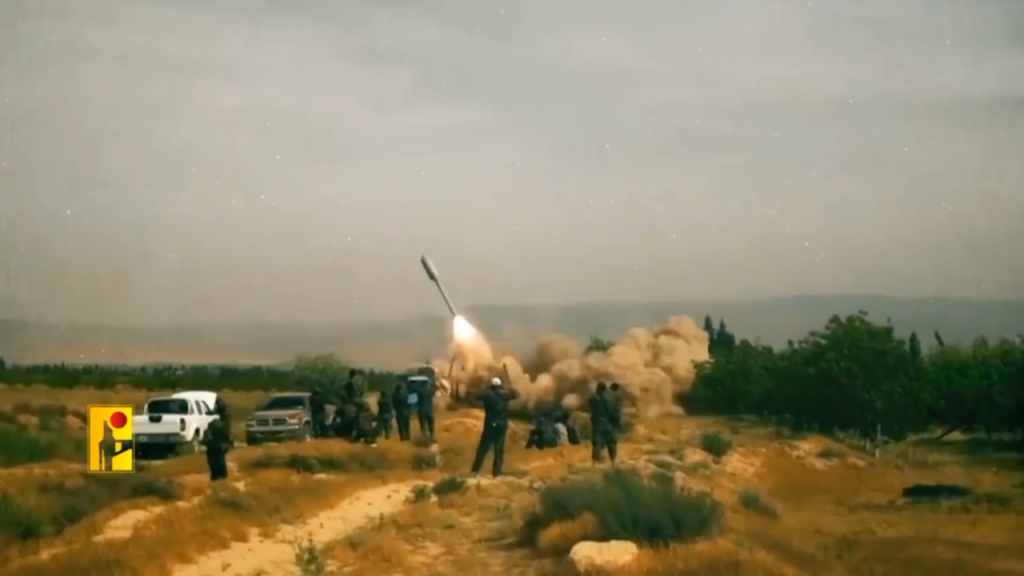
Falaq rockets
On January 26, Hezbollah assumed responsibility for firing Falaq-1 rockets, its first use of such rockets in the current war. The Falaq is a rocket that can carry about 50 kg of explosives and has a range of up to 10 km.

Anti-tank missiles
Hezbollah uses a variety of anti-tank missiles, including RPG, Sager, Fagot, Metis, Milan, and Kornet. Hezbollah uses these missiles to attack both military and civilian targets, such as buildings and vehicles. On January 27, 2024, Hezbollah claimed responsibility for the first time for firing an Almas anti-tank missile at a military base, an anti-tank missile with particularly high precision long-range capabilities, “fire and forget” capability, and a high-trajectory flight capable of hitting a target from overhead. For further details, see the article about the Almas missile.

Sniping
Hezbollah carries out sniper fire mainly at technical equipment, cameras and more.
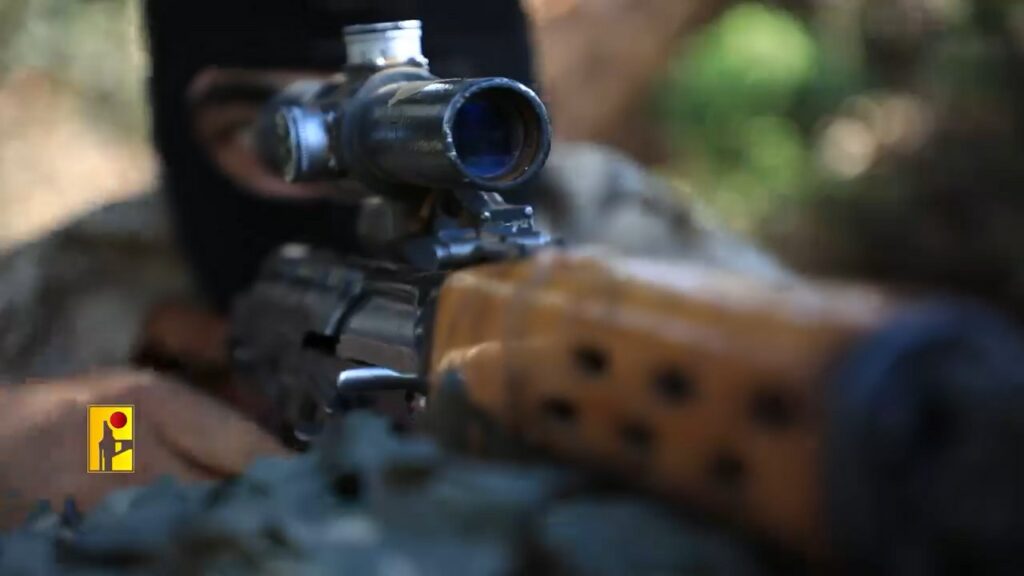
Air defense systems
Another type of weapon used by Hezbollah is air defense weapons. Since the beginning of the war, Hezbollah has been trying to intercept Israeli UAVs in Lebanon and on the border with anti-aircraft missiles. As part of preserving the idea of a “Lebanon shield,” Hezbollah claims that it is acting to keep Israeli UAVs away from Lebanese skies.
Since the beginning of the war, there have been at least 20 incidents of Hezbollah using air defense means. Hezbollah did not claim responsibility for all the incidents. Following are the significant events for which Hezbollah claimed responsibility:
- On October 29, 2023, Hezbollah claimed to have shot down an Israeli UAV with a surface-to-air missile east of al-Khiam. It is not known whether the UAV was shot down. This is the first incident in which Hezbollah claimed responsibility for firing a surface-to-air missile at an Israeli UAV.
- On December 20, 2023, Hezbollah claimed responsibility for firing surface-to-air missiles at two Israeli helicopters flying around the Israeli communities Shtula, Shomera and Ibn Menachem, claiming to have caused them to retreat.
- February 26, 2024 Hezbollah claimed responsibility for downing an Israeli Hermes 450 UAV. The incident was documented by residents of southern Lebanon and videos of the incident were circulated.
- April 6, 2024 Hezbollah claimed responsibility for downing Israeli Hermes 900 UAV and published a video documenting the attack.
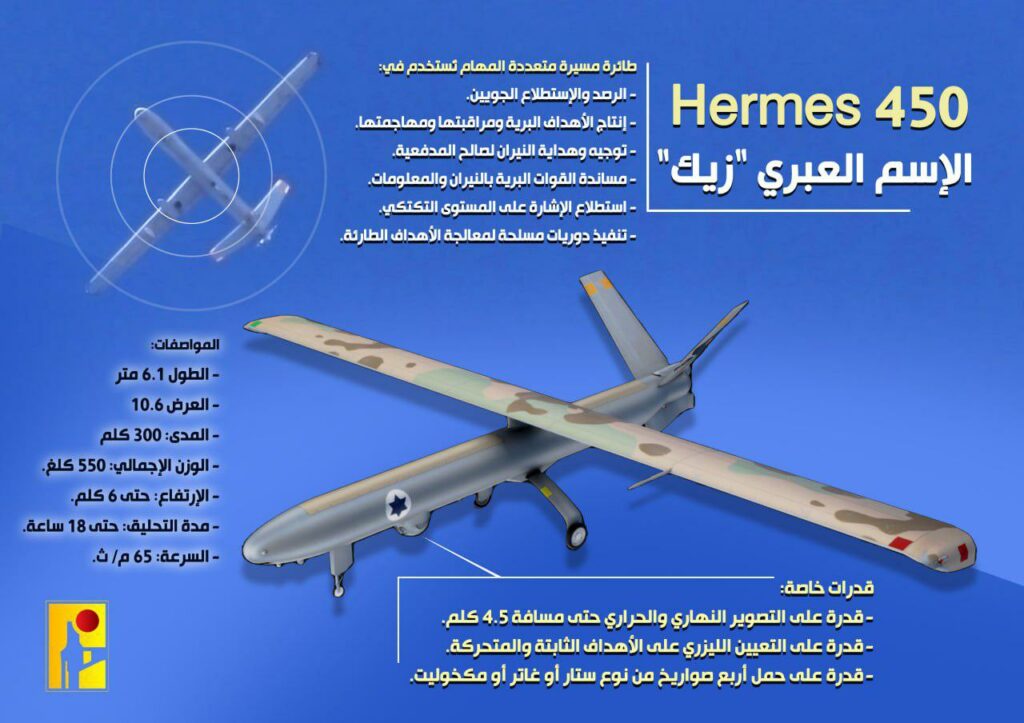
Hezbollah has increased the number of weapons it uses to target Israel since the war began. This is consistent with the attack equation against Israel, and as Israel expands its attacks, Hezbollah expands in response.
Appendix 3
Targets
Nasrallah detailed in one of his speeches that since October 8, 2023, Hezbollah has attacked three types of targets spanning more than 100 kilometers: military targets such as IDF outposts, military targets inside Israeli communities where IDF forces are stationed, and attacking Israeli civilians only in response to attacks on Lebanese civilians.
According to the data we gathered, 40% of the attacks target civilians. We define a civilian target as a direct and purposeful hit (according to Hezbollah’s claims of responsibility) and an attack that has a high likelihood of hitting civilian areas, particularly high-trajectory fire. This holds true even if Hezbollah has designated the claimed target as a military target. Examples of such events (attached bellow a video and photos):
- On December 23, 2023, Hezbollah claimed responsibility for firing Burkan rockets at a military base in the Western Galilee. In practice, some of the rockets fell in the city of Shlomi.
- On January 7, 2024, Hezbollah claimed responsibility for firing at the Israeli community of Metula, apparently using anti-tank missiles. The claim of responsibility asserted that the target was a military base near Metula, but in practice the missile was fired at a hotel in the center of Metula, in a clearly civilian area.
- On February 27, 2024, Hezbollah claimed responsibility for firing Grad rockets at a military base in the Western Galilee. In this incident, dozens of rockets landed in civilian areas, including on a major road in the Western Galilee.
- On March 12, 2024, Hezbollah claimed responsibility for firing about 100 Grad rockets at a military base in the Golan Heights, in practice dozens of rockets fell in civilian areas.


Hezbollah’s targets are changing and expanding in accordance with the IDF attacks in Lebanon. This is to continue to establish the equation of attacks vis-à-vis Israel – tit for tat. As a result, when the IDF strikes in Lebanon in a civilian area where Hezbollah operates, Hezbollah claims to attack civilian targets in return.
Appendix 4
The firing at the air traffic control base in Meron
During the present conflict, Hezbollah has attacked the Meron air traffic control base six times with missiles and rockets, not counting a single attack with hundreds of Grad rockets on the community of Miron. All the attacks came in response to substantial IDF attacks in Lebanon.
- On January 6, 2024, Hezbollah fired its first rocket at the Meron base. In its claim of responsibility, Hezbollah stated that it had fired 62 rockets of various types at the base as an initial response to the killing of Salah al-Arouri. The airstrike damaged the two defense domes at the base and some of the detection infrastructure in the air traffic control unit. However, the IDF emphasized at the time that the existing redundancy allowed the continuation of the unit’s activity and the damage was repaired.

- On January 23, 2024, another rocket attack was carried out. According to Hezbollah’s announcement, the attack was carried out in response to the recent eliminations in Lebanon and Syria and attacks on homes and civilians in Lebanon. Several of the rockets were intercepted, the base’s infrastructure was lightly damaged, and the IAF’s detection capabilities were not damaged.
- On February 8, 2024, Hezbollah fired Falaq rockets at the base, in retaliation for IDF attacks on villages in southern Lebanon and for the attack in Nabatiyeh in which Abbas Muhammad al-Debs, a senior commander in Hezbollah’s Radwan force, was killed.
- On February 27, 2024, two strikes were carried out. The first, a volley of dozens of rockets in response to the IDF attacks the previous day in Baalbek, attacking compounds used by Hezbollah’s air defense systems (the IDF’s response to Hezbollah’s downing of a Hermes 450 UAV with a surface-to-air missile). The second was carried out by firing anti-tank missiles, allegedly carried out due to IDF attacks on villages in southern Lebanon.
- As of this writing, the most recent attack was on March 26, 2024, using an Almas anti-tank missile, in response to the IDF strikes in Baalbek.
Appendix 5
Attacks Equation
During the war, we witnessed several cases that attest to the preservation of the equation of mutual attacks between the IDF and Hezbollah. Mutual attacks occur between 0 and 5 kilometers from the border, and when one side escalates the level of its attacks and hits a qualitative or more distant target, the other side increases its intensity appropriately.
Another equation based on the war is aerial: a strike by a Hezbollah UAV = an IDF attack on Hezbollah’s air unit’s targets. In that regard, an airstrike by Hezbollah using UAVs will be countered by an attack on a high-value target, reportedly linked to Hezbollah’s aerial system, deep within Lebanon. Furthermore, if anti-aircraft fire is used to attack an IDF UAV, the IDF will respond by attacking Hezbollah’s air defense systems. Hezbollah will respond by attacking air force bases that it alleges are part of the IDF’s air defense system.
This equation appears several times; here are some examples:
- On December 16, 2023 Hezbollah used a UAV to attack a target near the Israeli community of Margaliot. In response, the IDF attacked in the area of Khomin a-Tahta, about 45 kilometers from the Israeli-Lebanese border. This attack was considered the deepest attack in Lebanon since the beginning of the war.
- On February 19, 2024 a UAV launched by Hezbollah exploded in the Arbel area. In response, the IDF attacked weapons depots near the city of Sidon.
- On February 26, 2024 Hezbollah claimed responsibility for downing an Israeli Hermes UAV. In response, the IDF carried out several airstrikes in the Baalbek area against targets belonging to Hezbollah’s air unit, 100 kilometers from the border with Israel (for the first time since 2006). In response, Hezbollah fired around 60 Grad rockets at the Golan.
- On March 23, 2024 Hezbollah claimed responsibility for a UAV attack on an Iron Dome battery. In response, the IDF carried out an attack in Baalbek against a “weapons manufacturing workshop” (according to the equation created, the target may be connected to Hezbollah’s aerial system). Hezbollah’s response was expressed in the launching of about 60 rockets toward military bases in the Golan Heights.
- On April 6, 2024 Hezbollah claimed responsibility for downing an Israeli Hermes 900 UAV. In response the IDF struck several targets in Baalbek against a military complex and three additional terrorist infrastructure sites belonging to Hezbollah’s Aerial Defense Array. Hezbollah’s response was launching of dozens of Grad rockets toward military base in the Golan Heights.
